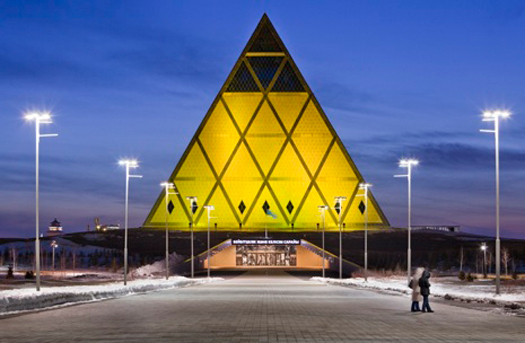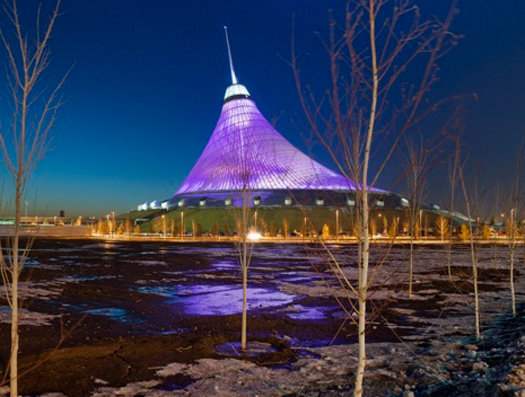
The Palace of Peace and Reconciliation, Astana, Kazakhstan; Foster + Partners, 2006; photograph by Richard Barnes
Last week's Journeys issue of the New Yorker was one of the magazine's best in months. And I think the digital powers that be know it, since much of the good stuff is behind little blue locks on the website. (One piece that isn't is Evan Osnos's Chinese bus trip through Europe: priceless.) The most architectural journey was Keith Gessen's to Astana, a.k.a. "Nowheresville," the new capital of Kazakhstan, where Foster + Partners has designed the Palace of Peace (above) as well as the Khan Shatyr Entertainment Center (below), which may be the world's first mall-slash-beach-slash-midway. Gessen's description seems equal parts Vegas, John Portman, and insanity.
Five levels of white balcony, small green plants spilling over the ledges, rise up toward the ceiling from the atrium, shops on the first two floors, restaurants and a cinema on the third, an arcade and game room, mostl for kids, on the fourth, complete with bumper-car track, and then, on the fifth, the beach.Bonus photographs by Richard Barnes in this slideshow.
The beach is on the top floor of the Khan Shatyr. In addition to the yellow sand shipped in from the Maldives and heated to create that beachlike feel, it has comfortable beach chairs, a pool-size swimming area for adults and one for kids, and a small water slide...The weekend fee is fifteen times the hourly wage of an Astana construction worker, but no one said it would be cheap to reverse the course of nature. From where I stood, sweating, a few bathers were visible, wearing small post-Soviet swim trunks, in one of the coldest cities in the world.
The story is great, but I did wish an architecture writer had been able to tag along for a more visual and archi-political commentary. I felt I couldn't "see" the city the way I wanted too, even after thousands of words. Gessen makes the geo-politics clear, but Astana also has to be seen in the context of Michael Murphy's recent essay, "The Poverty of Starchitecture." Kazakh President Nazarbayev was re-elected on April 3 with 95.5 percent of the vote. And in the context of Foster's own reputation, polished by his architecture and master planning of Masdar, the sustainable city in the desert outside Abu Dhabi, at the behest of another undemocratic state. (My earlier questions about Masdar here.) Foster's green credentials seem to slip in Astana, like those post-Soviet swim trunks.

Khan Shatyr ("King of Tents); Foster + Partners, 2010; photograph by Richard Barnes
The building at top, with its Boullean overtones, also made me think. First that indeed, postmodernism never left, as such colored shape-ism is in a direct line with Cesar Pelli's Pacific Design Center Blue, Green and Red buildings. And second, that perhaps Norman Foster and his many partners are our new McKim, Mead & White.
Why is he the go-to guy for new capitals? Because he knows how to do the axes, domes and pyramids that make a ruler feel like he has arrived. When America wanted to build its capitals of government and culture, McKim Mead & White and their Beaux Arts compatriots provided the same service. Cities Beautiful appeared across the land, with big flights of steps and broad boulevards, the better to see the buildings round, square, oval and winged. Instant recognizability. Instant pomp. It is precisely Foster's skill at reviving neo-Classical workhorses like the Reichstag, or the British Museum, that makes him able to invent new ones. He understands proportion, symmetry, depth of field, material. In the hands of a master ETFEs (the material of the Khan Shatyr) can impress like marble; that they have been shaped into a tent, a primitive architectural form, is a clever variation. It is architecture without architects of the highest tech. Foster returns to the pattern books, adds polymers, and plonks his shapes down in the steppe.
